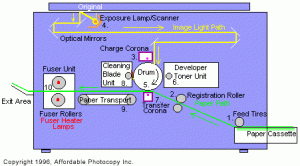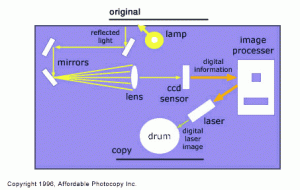Info Center
INFORMATION CENTER |
COPY PROCESS |
|
|
BASIC COPIER COMPONENTS and FUNCTION |
| 1. Paper Feed Tire(s) : Paper Feed Tires are soft gummy rubber tire which picks up the paper from the paper cassette and drives the paper to the Registration Rollers. Paper Feed Tire(s) are a consumable part. | |
| 2. Registration Roller : A soft rubber roller that synchronizes the leading edge of the copy paper to the leading edge of the image placed upon the drum. | |
| 3. Primary Charge Corona wire : A thin wire(s) housed in a lightweight metal slide framework that electrical charges the Drum. The charge produced by this assembly changes the sensitivity of the drum and allows the toner to be attracted to the drum for which that image will then be transferred to the copy paper. The thin charge wire(s) and accompanying insulating blocks are consumable parts. | |
| 4. Exposure Lamp : A tungsten-hallogen lamp. This Lamp lights up to reflect the image of your original to a series of lenses and optical mirrors and then onto the Drum. The Exposure Lamp is a consumable part. | |
| 5. Drum / Photoreceptor : A aluminum cylinder coated with a electrically and light sensitive film coating. The Drum actually accepts the image. With the drum being sensitive, appropriate areas of the drum are actually sensitized or desensitized according to the amount of reflected light of the image received. Toner is then attracted to the drum, from the electrical charge produced by the Primary Charge Corona wires and from the intensity of light received. The toner image on the drum will then be next transferred onto the paper. The Drum is a consumable part. | |
| 6. Drum / Photoreceptor : A aluminum cylinder coated with a electrically and light sensitive film coating. The Drum actually accepts the image. With the drum being sensitive, appropriate areas of the drum are actually sensitized or desensitized according to the amount of reflected light of the image received. Toner is then attracted to the drum, from the electrical charge produced by the Primary Charge Corona wires and from the intensity of light received. The toner image on the drum will then be next transferred onto the paper. The Drum is a consumable part. | |
| 7. Developer / Toner Unit (DV unit) : A modular unit which houses the developer and toner. Most machines (except Canon) utilize both Developer and Toner. Toner is basically micro fine ground up colored plastic with little or no magnetic / electrical properties. Developer is either finely milled iron filings or magnetic ferrite. The developer acts as a magnetic / electrical carrier which allows the toner to be carried from the magnetic developer roller onto the electrically charged sensitive drum. As with Canon’s patented NP (New Process) machines, the developer and toner are combined as one to be known as NP Toner. Developer and Toner are consumable supplies. | |
| 8. Transfer / Separator Corona wire : A thin wire(s) housed in a lightweight metal slide framework that electricaly attracts the image / toner formed on the drum onto the copy paper. At the same time this assembly aids in the separation of the electrically charged paper away from the drum so the paper can continue to the next process. The thin charge wire(s) and accompanying insulating blocks are consumable parts. | |
| 9. Cleaning Unit : A modular unit which mechanically removes the latent image from the previous copy made away from the drum. This unit not only generally contains a magnetic roller (like that housed in the DV unit) but also a Cleaning Blade. The Cleaning blade is nothing more than a silicone rubber strip attached to a metal bracket. This blade comes in direct contact with the Drum and physically removes the latent image from the previous copy made. The Cleaning Blade is a consumable part. | |
| 10. Paper Transport : A carriage like assembly supporting several rubber drive belts that transport the copied paper away from the Image Formation / Drum Area to the last and final Fusing process. The rubber drive belts are a consumable part. | |
| 11. Fuser Unit : The Fuser Unit actually fuses / permanently bonds the toner to the paper. This is generally accomplished by running the paper through two rollers (the upper roller being heated) that are under a pre loaded pressure and are often supplied with a silicone fuser oil. The Upper Fuser Roller (UFR) is heated with a temperature controlled tungsten-hallogen lamp (similar to the exposure Lamp). This UFR is a hard roller that is coated a nonstick / easily cleanable silicone or Teflon coating. The Lower Fuser Roller (LFR) are generally not heated and coated with a soft blanket of red silicone rubber. Many machines utilize a Fuser Oil or silicone impregnated Cleaning Roller(s) to aid in the fusing of the toner to the paper and avoid the copied paper sticking to the rollers. The UFR, LFR, Roller Shaft Bearings, Heater Lamp, Cleaning Roller(s), and Fuser Oil are all consumable parts. |
BASIC COPY PROCESS |
| Upon placing the original to be copied and then pressing the Print Button the following sequences occur : |
| Exposure Process : The Exposure Lamp (4) illuminates original image and refracts this image through a series of mirrors thus enabling this image to reach the photosensitive (light sensitive) Drum (5), and at the same time paper is drawn into the machine from the paper cassette by means of the Feed Tires (1). | |
| Image Formation Process : The Drum is electrically charged by the Primary Corona Charger Assembly (3) in preparation to receive the refracted image of the original. With the different graduations of light to dark areas of the refracted image striking the electrically charged drum, this sets up a masking / desensitizing effect on the drum. The sensitized areas left masked on the drum will accept and draw the electrically attracted toner from the DV Unit (6) to be placed on the Drum to produce an image. | |
| Registration Process : This enables the image on the drum to be properly “registered” or aligned onto the paper. With the leading edge of the image formed on the drum, and the leading edge of the paper traveling through the machine, they will both meet in unison by means of the Registration Roller (2). | |
| Transfer Process : This is the process in which the image from the drum is transferred onto the paper. The transference of the toner from the charged drum onto the paper is carried out by the Transfer Corona Assembly (7). To put it simply the drum and the toner on the drum have a (+) charge, and as the paper passes beneath the drum , the Transfer Corona produces a (-) charge and with this transfer charge assembly placed beneath the paper that is passing underneath the drum, this causes the toner to be drawn off of the drum and onto the paper, thus the image is transferred onto the paper. | |
| Cleaning Process : This process cleans any residue / latent image that is left on the drum and was not fully transferred to the paper. This residual image on the drum is then wiped clean by the Cleaning Blade Unit (8) and captured as Waste Toner. The copied paper is simultaneously carried via the Paper Transport (9) to the next and final process (the fusing process). | |
| Fusing Process : This process permanently fuses / bonds the toner to the paper. With the loose toner image on the copied paper reaching the Fuser Unit the image / toner is then fused permanently to the paper by means of heat, roller pressure, and generally a silicone oil. | |
|
|
|
DIGITAL COPIER TECHNOLOGY |
| Digital copiers can easily become your perfect All-In-One Machine. They are often referred to as a “One-Stop Document Processing Center”, “MFC Multi-Function Copier”, or “Total Office Solution”. Digital Copiers are very well suited for expansion of their capabilities. With options installed, a Digital Copier can be expanded to a digital laser network printer, scanner and fax. They also allow fast first generation copying/printing (an original output each and every time). These machines can be the perfect office solution for many companies. |
|
| With a Digital Copier, once an image is digitally scanned into the machine, it is broken down into pixels and saved in the memory. From that point, unlike an analog copier, the image is copied directly from memory and does not need to be scanned again. This cuts down on the wear and tear of mechanical components as well as greatly reducing the energy used to produce x amount of copies. |
|
| Another, and probably the greatest, advantage to digital copying is that when an image is in pixel format gradations or greyscales can be handled much better than with analog machines. This means that digital machines excel at copying photos and/or artwork. Also, a digital image is more easily manipulated ( zoom, reduction, etc. ) then an analog one. While, generally, an analog image can only be magnified 200%, a digital image can have a much extended magnification limit. |










